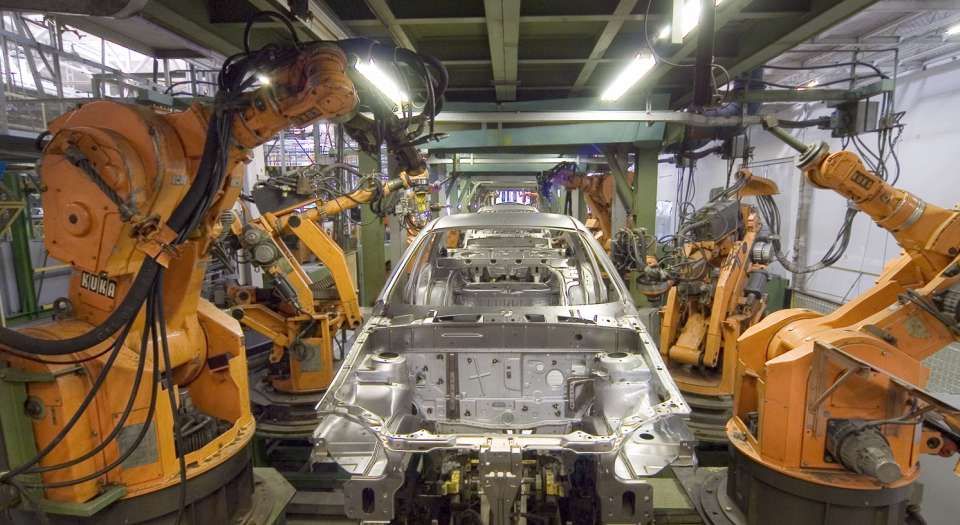Seven reasons we should celebrate manufacturing
Commentators bemoaning the rise of ‘stuffocation’ miss the benefits manufacturing provides.

Want unlimited, ad-free access? Become a spiked supporter.
Despite the slew of advertising for fashion, cars and appliances, hostility to ‘stuff’ – manufactured products – has grown enormously in recent years.
Books have been published in America, Australia and Britain on the subject of what they call ‘affluenza’, the nasty and even infectious side-effects of owning too much stuff. Since 2011, two American corporate high-flyers, Joshua Fields Millburn and Ryan Nicodemus, have together penned seven books on so-called minimalist consumer habits – quite a feat of trees-to-paper consumption in itself. The London-based futurologist James Wallman has popularised the idea of ‘stuffocation’ – the feeling you get ‘when you look in your wardrobe and it’s bursting with clothes but you can’t find a thing to wear’. And every Christmas, the Guardian denounces consumers for a ‘peculiar form of mental illness’: buying toys, smart cuckoo clocks or mahogany skateboards, and failing to feel guilty about it.
Ironically, though, UK manufacturing, an ancient carthorse, is now showing signs of life. Other than motorcycle manufacturer Triumph, there are no major British-owned automotive firms, but foreign-owned firms are beginning to boom. Since 2010, UK output in pharmaceuticals has dropped by about 20 per cent; but in capital goods, output is up more than 10 per cent and, in transport equipment, by nearly 30 per cent. Overall, manufacturing output in the first quarter of 2014 was more than three per cent higher than during the same period 12 months before.
In Buddhist tones, effete environmentalists urge the British public to cease its renewed activity. Yet the public still needs manufactured goods – 60 per cent of British households, for instance, still don’t have a dishwasher, and, indeed, sales of dishwashers have fallen since 2007. Yes, as spiked has noted, there is a crisis in Western research and development (R&D). Yes, Western manufacturers often fear making capital investments, and avoid taking risks around new product development. However the world’s manufacturing sector has lately begun to chalk up impressive advances.
Do these advances amount to what Peter Marsh, an encyclopaedic analyst of manufacturing, terms ‘the new industrial revolution’? Do these advances presage what he calls ‘the end’ of mass production? Hardly. Yet whatever setbacks they are likely to face over the next 10 years, scientific, technological and economic developments promise a world of cheaper, more sophisticated products than the ones available today. Instead of heaping yet more scorn on manufacturing, there is much it has to offer humanity and progress. Here are seven new developments in manufacturing we should celebrate.
1) Computer Aided Engineering (CAE) should mean fewer product recalls
In recent months, GM, Ford, Toyota and even Mercedes have all had to take defective cars back for modification. So far this year, GM and Toyota have recalled 11.2million vehicles. With GM, at least, the design and engineering errors which are behind the recalls stem back years. Still, new developments in Computer Aided Engineering (CAE) should make product glitches less frequent in the future.
CAE has come a long way since its inception in 1963. Then, at America’s Massachusetts Institute of Technology (MIT), Ivan Sutherland’s Sketchpad program first brought together graphical user interfaces and Computer Aided Design, by offering the user a light pen with which to fix coordinates on a cathode ray tube. A big breakthrough then took place in 1990, with Dassault Systèmes’ creation of Digital MockUp (DMU). Deployed in the run up to Boeing’s 1995 launch of its 777 airliner, DMU helped Boeing eliminate 65 per cent of engineering errors before it committed the aircraft to production.
So what has changed today? At companies like Jaguar Land Rover and Caterpillar, engineers and designers previously would work from small, virtual 3D models on 2D computer monitors; they have now moved towards using ‘immersive visualisation’, working at 1:1 scale. And there is more. Immersive visualisation, which simulates and tests both designs and whole assembly lines, has become cheaper and less time-consuming to set up and operate. Synchronised computers, 3D glasses and stereographic, jitter-free images at 50Hz-per-eye now improve driver visibility in mechanical excavators and cars, as well as helping to ensure that parts do not collide with each other in factory production or in service routines.
Just as much as lowering costs, today’s CAE should help to rationalise product designs and make them more beautiful while improving process and product safety. And, as it becomes more ubiquitous, CAE will begin to be used in much the same way as a PC, coordinating many different types of data, workstations, software versions and users, as well as linking more smoothly to 3D printers.
Progress is too slow, and incompatibilities between different CAE systems are still rife. Nevertheless, CAE should clarify and shorten what’s known as the ‘fuzzy front end’ of developing new products – that early stage when uncertainties are high but costs are not yet burgeoning. So CAE will bring finished, high-integrity, innovative products to market more rapidly than in the past. It will also cut the cost of making manufacturing’s machine tools (2).
These advances are a smack in the eye for critics of ‘stuff’, but good news for the rest of us.
2) Product autonomy via printable, light, strong and stiff materials
At a fine Royal Academy of Engineering seminar in November, I was struck by the magic of carbon fibre (developed in 1958), carbon nanotubes (popularised in 1991), one-atom-thick graphene (produced in 2004), and the prospect of artificial human tissue and bone through ‘synthetic biology’. Here, stiff, high-strength-to-weight materials are gaining new applications.
Carbon fibre can now be printed like plastics, yet remain tougher than aluminium. Or, take graphene. ‘Large area’ graphene is now being used in displays, sensors, optics, flexible electronics and flexible solar panels. ‘Flake’ graphene lends itself to batteries, supercapacitors, food and drink packaging, and membranes for the desalination of water and the purification of fluids. Through graphene, mankind has gained better ways of conducting electricity and heat, as well as new knowledge of what all kinds of materials can do when in the form of 2D layers.
There is more. Provided they are coupled with new industrial processes, clever glues (‘paste adhesives’), like aluminium-lithium alloys, make a plane such as the Airbus 380 or the Airbus 350 lighter, lowering the amount of fuel needed to fly it. Anti-reflective coatings for metals, polymers and glass are self-cleaning, self-healing, anti-bacterial, anti-fogging and water-repellent.
Materials, like machines, will never be truly ‘intelligent’ or ‘smart’. Yet, in their development, they attest to great human ingenuity. In solar panels, we can mix the low cost and flexibility of polymer-based films with stable inorganic nanostructures. That could push us on to punchier, longer-lasting, fourth-generation photovoltaics. In medicine, titanium and polyether ether ketone can now be 3D-printed to make replacements for human jaws and cranial implants. In synthetic biology, modular principles and the insertion of genetic codes into microbes have brought new plastics and new varieties of yeast, as well as collagen and magnetically controlled bacteria. Another opportunity lies in synthetic versions of the proteins that go to make up spider silk. These proteins will help in the manufacture of cables, bulletproof vests, wound patches and artificial tendons.
The materials being developed today make for less human labour and more useful products. And, contrary to environmentalists’ fears about ‘stuff’ bringing about resource depletion, supplies of materials are plentiful. Hydrocarbons, essential feedstock to plastics, are every year the subject of new discoveries (3). Also abundant, despite their name, are rare earths; used to make batteries, compact fluorescent lights and LED lighting, as well as the permanent magnets in direct-drive wind-turbine generators, electric vehicle motors and hospital MRI scanners, rare earths were the subject of an anti-Chinese resource scarcity panic in 2012. Yet reserves of them exist worldwide. More than 60 per cent of rare earth reserves lie outside China, and worldwide reserves are ‘thought to be very large relative to expected demand’ (4).
3) Printed electronics ‘functionalise’ product surfaces
3D printing has been the subject of unbridled hype. Yet, when 3D is put to work to print electronic components on product surfaces, it remains a powerful technique. Thermo-electric and solar energy, LED lighting, sensors in home appliances, responsive packaging and labelling, wearable devices and high-efficiency, colour-tunable displays: all these things will benefit from printed electronics.
In Bremen, north Germany, the Fraunhofer Institute has installed a robot production line with all kinds of printing heads – silk-screen, inkjet, dispenser, and aerosol-jet – to dispatch, feed, print and heat-treat, in furnaces, multilayer circuits of varying thickness, as well as sensors that can register factors like temperature and strain. The line prints in metals, ceramics, electrically conductive polymers, proteins and enzymes, and on to glass, textiles, metals, ceramic plates, car bodies, windowpanes and other building components. Meanwhile, in the US, Rice University researchers have layered nanoporous nickel-fluoride electrodes around a solid electrolyte of potassium hydroxide in polyvinyl alcohol. The result is thin, flexible, wearable, long-life, lithium-free batteries.
Apart from their use in displays and sensors, electronic components have, in the past, mostly been confined to mountings on the insides of products. Gradually – too gradually – they will now come to be printed on the outside of products. This process will make everything from machine tools to consumer products more versatile, and easier to use.
Of course, some know-it-alls are still discovering, nearly 30 years after Ruth Schwartz Cowan’s breakthrough book, More Work for Mother (1985), that labour-saving consumer appliances don’t, under capitalism, prevent women and especially mothers from continuing to have to work hard in the home. Yet, the extra capabilities and convenience that printed electronics ushers in are welcome. They will give us better ‘stuff’ to look forward to, in elusive dishwashers and still-to-come home robots as much as the ubiquitous mobile phone.
4) Thankfully, Asia’s supply networks are more diverse than ever
Since 2008, the globalisation of manufacturing has intensified, particularly in Asia. There, labour remains cheap, but, in China and elsewhere, wages have been rising, enough for the Financial Times to lament that Myanmar might be ‘the last bastion of cheap manufacturing’ were it not for India and its ‘huge pool of young labour’.
India may now be able to reserve for itself, says the FT, a serious spot in the world’s supply chains. Yet we should remember that labour often forms a relatively small proportion of the outlays made by capitalist manufacturers, even in India. As manufacturing has gone more global, so it has helped mechanise the developing world, and wages in Asia have risen alongside this process.
This mechanisation of Asian manufacturing is a good thing. So, too, is the accompanying multiplication of sources of supply. Of course, Western firms have long played off the workforce of one country against that of another. Yet, in part because it is accompanied by the spread of IT, today’s diffusion of more-or-less high-tech manufacturing, though still patchy, may one day see new forms of international solidarity emerge.
Anyway, given the world’s need for a reliable supply of products, the globalisation of supply options is good news. Since the 2011 Tōhoku earthquake and tsunami in Japan, Western manufacturers have sought out new suppliers ready to assist when disruptions occur. The need now is not just for the one manufacturing supply chain of old, but for fully articulated manufacturing supply networks. In turn, that has brought about an important change.
In May 2013, the Swiss-based audit firm KPMG highlighted giant manufacturers’ need for ‘visibility’ in their supply networks, urging them to demand the fullest kind of information from their suppliers, and from their suppliers’ suppliers (5). Now, obviously this call for visibility in supply chains amounts to Western firms trying to squeeze everything out of their suppliers – knowledge, profit margins and all the rest. Yet, from a technical point of view, at least, it is indeed wise for manufacturers to work closely with their suppliers in synchronising product specifications and designs. Today’s large manufacturers are right to use the visible information now provided by IT to swap ideas without the interference of patent lawyers. This helps to gear production to demand, provide options in reliability, quality and transport, and improve delivery and customer service.
Less forgivable is KPMG’s hope that visibility will provide a means of scrimping and saving on inventory, operations and capital expenditure. Less forgivable still, however, are Western moral postures around the ‘transparency’ of today’s supply chains.
The transparency of every aspect of developing-country supply chains has for some years stirred liberal onlookers in the West. The passions move from clothes retailer Primark’s reputed responsibility for an urban fire in Bangladesh in April 2013, through to alleged human-rights and environmental abuses in the oil, gas and mining industries, and on to corruption – especially corruption in Asia. Things have reached such a point that Intel, the world’s largest manufacturer of microchips, boasts that the materials used in its processors are ‘conflict-free’ – untainted by association with militias and rebel groups in places such as the Democratic Republic of Congo. Significantly, Intel also boasts about its talent to ‘work cooperatively’ with metal smelters and refiners in Asia and the Middle East, to ensure that they, too, join the Californian company’s crusade for peace.
It is wrong to think that all this do-gooder posturing doesn’t work to the advantage of Western manufacturers. It is for workers in Asia and other developing countries, not the missionary efforts of Western NGOs, to deal with the downsides of globalisation. For the rest, the push of manufacturing supply chains into new countries, especially in Asia, is a gain for humanity, nothing less. Like nearly everyone, the teeming masses of Asia need and deserve more stuff.
5) Africa could be a manufacturing hub by 2024 – if the West stops ordering drone strikes
Nowadays, the West likes to see Africa as a place full of abductions, corruption, bureaucracy, weak financial services and kleptocrats intent on profiting from indigenous oil or mineral reserves. Yet as early as December 2009, Robert Zoellick, then president of the World Bank, reported that China’s minister of commerce was interested in ‘moving some of the lower-value manufacturing facilities to sub-Saharan Africa’. In August this year, the US Department of Commerce, along with Bloomberg Philanthropies, will host the world’s first US-Africa Business Forum. Its aim: to boost trade and US investment in Africa – including investment in African consumer goods and IT.
In potential, at least, Africa could sidle up to Asia as a manufacturing hub over the next 10 or 20 years (6).
All kinds of manufacturers are now interested in Africa. SRAM, a Chicago-based maker of bicycle components, beer giant Heineken, and a Japanese leather-products company named Hiroki have set up shop in Ethiopia. Renault-Nissan has started making black Patrol vehicles in Lagos, Nigeria, and General Electric will make electrical gear there, too.
Between 2000 and 2009, Africa’s exports doubled, in nominal terms, in sectors including machinery, transport equipment and processed commodities. Significantly, most of the exports went to African and smaller developing countries, not just to giants such as China. The deployment of IT in emerging African factories may also be assisted by the fact that IT vendors can start their operations fresh on the continent.
Such factors go in Africa’s favour as a new source of manufacturing supply chains. But increased manufacturing also works to stabilise working conditions, in Africa as much as anywhere else. However, Western intervention in Africa threatens to divert it away from much-needed progress in manufacturing. The US has hundreds of handpicked commandos stationed in Libya, Niger, Mauritania and Mali. In the wake of recent events, Britain’s fleet of Reaper drones is likely to be reassigned from Afghanistan to Africa and the Middle East. France and now even Germany are militarily active in Africa. Yet we can be sure that any and all Western interventions there will exacerbate ethnic and religious tensions, stoke terrorist sentiment and impede any take-off in manufacturing.
It is time Africa more fully satisfies its need for stuff. More than Western investors in African manufacturing, meddlers in Western governments are the main barrier to this.
6) Shops should adopt industrial and media technologies
So how does the growth in manufacturing impact on the relationship between manufacturers and retailers? For years, retailers of food and drink, an important part of manufacturing, have had the upper hand on manufacturers. Similarly, fashion retailers, such as Burton or Marks & Spencer, hold immense power over their suppliers. Yet recent advances in manufacturing could give manufacturers more sway over retailers. By selling smart, hi-tech products to retailers, manufacturers could help the high street become a very different place.
In order to overhaul ‘bricks-and-mortar’ retailers in response to the challenge from online shopping, retailers must raise productivity in shops and reduce prices. The industry must also transform the high-street shopping experience into something more interactive and pleasurable. It is not quite to my taste that celebrity chef Heston Blumenthal has wedged a wood-burning oven into Heathrow’s Terminal 2, or that, in the same location, Thomas Pink, a retailer of shirts, allows customers to design their own. Nevertheless, these changes give a hint of the opportunities now facing suppliers of equipment to shops.
In terms of mechanising shops to higher levels of efficiency, Ocado Technology has made some strides. At sites in Hatfield, UK and Krakow, Poland, Ocado has developed a vision system for warehouse robots, which work alongside staff to pick goods among 40,000 stock-keeping units and bundle them into customer ‘totes’ which move at 25 kilometres per hour. Might something like this, suitably tweaked, one day take the place of the stacking of shelves by low-paid workers?
On the other hand, in-store sense-and-display screens, electronic fitting rooms and graphene shelves or ceilings complete with integrated lighting could give manufacturers a whole new market. At MIT, researchers have used silver nanoparticles as a coating for shop windows, turning them into head-up displays that can handle projections of merchandise and be visible from any angle. Meanwhile, new materials have ridden to the rescue of holographic movies, with photorefractive polymers and composites now requiring only low electric fields and the tuning of wavelengths to begin to generate eyewear-free 3D movies – something of great interest to retailers.
7) Products as waste: automated recycling over a ‘circular’ economy
For environmentalists, manufacturing has given us a ‘linear’ economy – take raw materials from the ground, make stuff, throw it away. Instead, such critics call for a ‘circular’ economy, in which the components of manufactured products are reduced, reused or recycled so that all waste is put back into the system.
Let us leave aside the fact that exploitation, let alone wealth and income inequality, tends to suggest a vertical economy rather than a linear one. And it should be noted that state officials and giant corporations have loved the idea of a circular economy for years (7), given that ‘its local low-carbon and low-resource solutions… are inherently more labour-intensive than manufacturing as economies of scale are limited’.
That says it all. Reusing and recycling waste is a time-consuming affair. Yet, as automation proceeds in manufacturing, so it can be applied to product waste. With electronic waste, which is widely and illegally transported from the US for low-tech and often dangerous handling in Asia and Africa, there are openings for the automated recycling of printed wiring boards and of the surface-mounted components – resistors, integrated circuits – in printed circuit boards. This involves deploying the techniques of automated optical inspection, pyrometallurgical processing and hydrometallurgical processing (8).
Alarm about manufacturing generating waste is as misplaced as alarm about manufacturing’s depletion of the world’s resources, given that the amounts of waste produced by England’s commercial, industrial and residential sectors are declining (9).
Conclusion
There is no need to be sentimental about manufacturing or nostalgic about past British engineering triumphs, whatever the merits of the Jaguar E-type or the Mini (now made by BMW). Yet, manufacturing, while posing many challenges, is still capable of making leaps and bounds.
Stuff has got a bad rap. This, however, says more about the disenchantment of elites with material progress than it does about manufacturing. The world needs more and better stuff – and the signs are that it will get it.
James Woudhuysen is professor of forecasting and innovation at De Montfort University, Leicester, and editor of Big Potatoes: the London Manifesto for Innovation. Read his blog here.
Additional research by Paul Reeves
You’ve read 3 free articles this month.
Support spiked and get unlimited access.
Help us hit our 1% target
spiked is funded by readers like you. It’s your generosity that keeps us fearless and independent.
Only 0.1% of our regular readers currently support spiked. If just 1% gave, we could grow our team – and step up the fight for free speech and democracy right when it matters most.
Join today from £5/month (£50/year) and get unlimited, ad-free access, bonus content, exclusive events and more – all while helping to keep spiked saying the unsayable.
Monthly support makes the biggest difference. Thank you.








Comments
Want to join the conversation?
Only spiked supporters and patrons, who donate regularly to us, can comment on our articles.